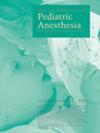耳穴激光针灸作为儿童手术期间家长焦虑管理的辅助手段:随机对照研究
IF 1.7
4区 医学
Q2 ANESTHESIOLOGY
引用次数: 0
摘要
背景儿科手术会给患儿和家长/护理人员带来高度焦虑。为了减轻焦虑,耳穴针灸在围手术期环境中显示了其潜力。因此,我们的团队开发了一种可穿戴的耳穴激光针灸系统原型 AcuHealth V1.0,作为一种便携式针灸设备,并对接受手术的儿童家长进行了概念验证评估。方法将计划接受门诊手术的儿童家长随机分配到三组中的一组:正宗针灸组(激光束照射已知抗焦虑穴位,n = 13)、假针灸组(非抗焦虑穴位,n = 14)或安慰剂对照组(非活性激光,n = 14)。在基线、干预前(孩子被送往手术室后)、干预后和干预后 30 分钟,对家长自我报告的焦虑程度(0-10 分数字等级表)进行评估。结果基线数据显示,三组之间的焦虑程度无明显差异。与假针灸组(-1.35 ± 2.65)和安慰剂对照组(0.54 ± 1.13)相比,真针灸组干预后 30 分钟家长报告的焦虑水平与基线相比明显下降(delta 平均值 ± std = -3.58 ± 2.07)。使用双向重复测量方差分析(ANOVA)评估各组间家长报告的焦虑随时间的变化,结果显示三组间存在显著差异(P = 0.001)。通过 Scheffe 检验配对比较进行的事后分析表明,干预后 30 分钟与基线相比,真实干预组的焦虑程度明显低于假干预组(p = 0.033)和安慰剂对照组(p = 0.001)。结论这项试点研究通过 AcuHealth V1.0 系统实施激光耳穴疗法,在孩子被送入手术室后立即接受治疗的家长在 30 分钟后的焦虑程度有所减轻,且无不良反应。本文章由计算机程序翻译,如有差异,请以英文原文为准。
Auricular laser acupuncture as an adjunct for parental anxiety management during children's surgery: A randomized‐controlled study
BackgroundPediatric surgery is associated with high levels of anxiety for both children and parents/caregivers. To mitigate anxiety, auricular acupuncture has shown its potential in the perioperative setting. Accordingly, our team developed a wearable prototype auricular laser acupuncture system, AcuHealth V1.0, as a portable acupuncture device and conducted a proof‐of‐concept evaluation with parents of children undergoing surgery.AimsThe primary aim of this study was to conduct feasibility testing of the AcuHealth V1.0 system in delivering auricular laser acupuncture.MethodsParents of children who were scheduled to undergo outpatient surgery were randomly assigned to one of three groups: authentic acupuncture (laser beams at known anxiolytic acupoints, n = 13), sham acupuncture (non‐anxiolytic acupoints, n = 14), or a placebo control group (inactive laser, n = 14). Parent self‐reported anxiety (0–10 numerical rating scale) was assessed at baseline, pre‐intervention (once child was taken to the OR), post‐intervention, and at 30 min after the intervention. Usability and acceptability data regarding the device were assessed after the intervention.ResultsBaseline data revealed no significant difference in anxiety between the three groups. Parent‐reported anxiety level at 30‐min post‐intervention as compared to baseline in the authentic group was significantly decreased (delta mean ± std = −3.58 ± 2.07) compared to both the sham acupuncture (−1.35 ± 2.65) and placebo control group (0.54 ± 1.13). Evaluation of changes in parent‐reported anxiety between groups over time using two‐way repeated‐measures analysis of variance (ANOVA) revealed a significant difference between the three groups (p = 0.001). Post hoc analysis with Scheffe test pairwise comparisons showed that at 30‐min post‐intervention compared to baseline, the authentic intervention group was significantly less anxious compared with both the sham group (p = 0.033) and the placebo control group (p = 0.001). Additionally, feedback regarding the usage of the device supported the acceptability and usability of the device with no adverse events.ConclusionsThis pilot study administering laser auricular acupuncture via the AcuHealth V1.0 system decreased parental anxiety after 30 min in parents who received treatment immediately after their children were taken to the operating room with no adverse effect.
求助全文
通过发布文献求助,成功后即可免费获取论文全文。
去求助
来源期刊

Pediatric Anesthesia
医学-麻醉学
CiteScore
3.20
自引率
11.80%
发文量
222
审稿时长
3-8 weeks
期刊介绍:
Devoted to the dissemination of research of interest and importance to practising anesthetists everywhere, the scientific and clinical content of Pediatric Anesthesia covers a wide selection of medical disciplines in all areas relevant to paediatric anaesthesia, pain management and peri-operative medicine. The International Editorial Board is supported by the Editorial Advisory Board and a team of Senior Advisors, to ensure that the journal is publishing the best work from the front line of research in the field. The journal publishes high-quality, relevant scientific and clinical research papers, reviews, commentaries, pro-con debates, historical vignettes, correspondence, case presentations and book reviews.
 求助内容:
求助内容: 应助结果提醒方式:
应助结果提醒方式:


